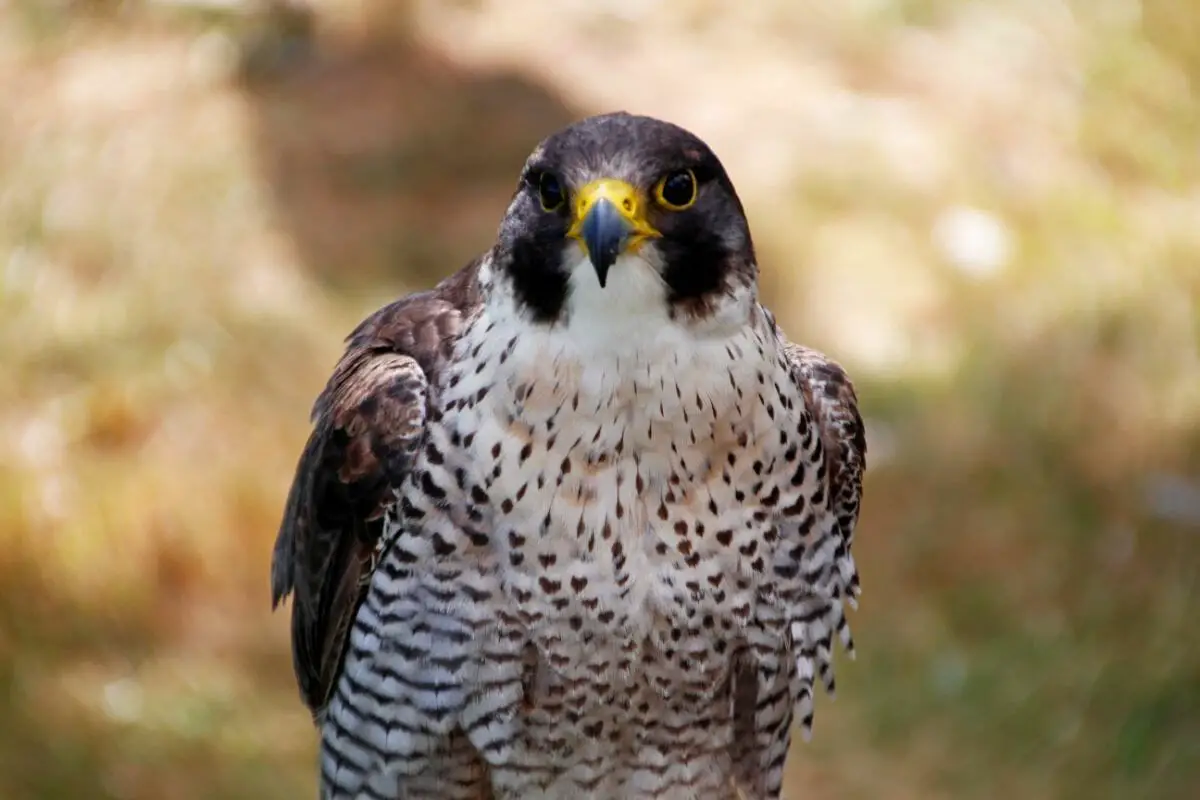Every continent, with the exception of Antarctica, is home to one of the approximately 40 species of falcons, and while there are many differences among them, they all have several lethal traits in common.

The birds’ slender, tapering wings, which let them soar at nearly 200 mph and get the most of those razor-sharp talons and savagely hooked beaks, are what make them stand out.
Falcons often use their agility to dive bomb their prey, and their physiques have changed over generations to make this strategy more effective.
They use their sharp and potent beaks to kill their food. Usually, they use their sheer momentum to knock their airborne or ground prey off balance.
Here are five well-known falcon bird species, along with details on some of these unique species’ particular characteristics.
Peregrine Falcons
Peregrine falcons are the most common and widely distributed raptors in the world, demonstrating just how dangerous and potent these birds are.
Because peregrine falcons are always apex predators, regardless of the ecosystem they are in.
Researchers have also found evidence of possible prey species, such as the western sandpiper, altering their migration routes in order to avoid areas where peregrine falcon populations are concentrated.
There are several justifications for this. Other birds are most likely targets of a peregrine falcon’s attack since its diving speed can be comparable to a cheetah’s peak speed.
Peregrine falcons typically hunt on pigeons, but they have also been seen to snag ducks and songbirds.
They were severely harmed over recent decades by the widespread use of DDT as well as other pesticides, but they have recovered wonderfully because of their exceptional hunting abilities.
Grey Falcons
There are only about 2,000 grey falcons left in the world, and you can find them all hunting throughout Australia and neighboring Tasmania.
This bird has a very similar body type to the peregrine falcon and uses comparable hunting strategies while being a little smaller.
They typically favour open meadows, deserts, and prairies (Also check out Animals You Can Find On The Prairie) so they may pounce on unaware prey.
About 88 percent of a grey falcon’s diet consists of smaller birds, primarily songbirds, budgerigar, and pigeons, though they have also been known to eat small mammals and reptiles.
Along the coast, grey falcons have been spotted snatching up fish that have surfaced.
Grey falcons are among the top predators in any environment they live in, despite being endangered, and this comes with a lot of benefits.
Among the most practical benefits is that grey falcons never have to construct their own nests.

nstead, they’ll use the nests that ravens and other raptors have already made.
Since these birds normally only lay up to three eggs per season, achieving greater levels of population sustainability is more challenging.
Wide hunting grounds are used by grey falcons, whose number is declining in significant part as a result of agricultural activities used by humans.
American Kestrels
Although the typical American kestrel is around the same size as a blue jay, they nonetheless possess the same deadly instinct and aggressive personality as their larger relatives.
They are currently acknowledged as the most prevalent hawk in the U. S. and are among the most successful raptors on the planet.
These birds hunt considerably less prey than the typical peregrine falcon due to their lower size.
The American kestrel often eats big insects such as caterpillars and grasshoppers in addition to smaller birds, amphibians, reptiles, and small mammals like voles and mice.
Even though this species is common throughout all of its habitats in the United States, there are still significant risks to it.
American kestrels are frequently killed by humans along its migration route and are frequently preyed on by the bigger birds of prey – notably Cooper’s hawks.
While not all populations of American kestrel show migratory habits, those who reside near the ocean are more inclined to do so than those who dwell farther inland.
This may be because fall and winter weather are better in interior North America.
The American kestrel isn’t going anywhere despite the dangers it faces throughout this lengthy trek.
With a combined population of around four million, this kind of falcon bird is one of the most numerous among the several varieties.
The gyrfalcon is renowned for being the largest of the various species of falcon birds.
The normal gyrfalcon has a wingspan that is around two feet and weighs about three pounds.
Gyrfalcons
Gyrfalcons must eat around half their body weight in food each day during the mating season due to their large size and heft as well as the high energy requirements of sustained flight.
Gyrfalcons eat mostly the one-pound rock ptarmigans that live in their habitat, and the populations of the species are closely synchronised.
Gyrfalcons aid in the control of ptarmigan numbers, but it’s unlikely that they would continue to exist like they do today without them.
They have also been observed eating owls, songbirds, ravens, and gulls.

Because of their chosen habitat, the High Arctic, gyrfalcons are currently mostly unaffected by human activity.
Taiga (Also check out Animals That Live In The Taiga Biome) and tundra provide a wide-open perspective for seeing prey, whereas cliffs and trees make ideal perches for waiting to strike.
Most of these birds move too far north to be observed in the north of the United States and Canada, but they are hardly ever spotted in populated regions.
Aplomado Falcons
The Aplomado falcon, which may be found all throughout North America, has been listed as an endangered species since 1986 and is the only one that is still doing so in the United States.
The majority of Aplomado Falcons are now found in Central and South America, while conservation programs have resulted in a tiny population in Texas.
Aplomado falcons have had to adapt more advanced survival techniques than falcons whose habitats are broad plains and valleys since they had to live in heavily forested tropical areas.
Hunting in pairs or family groups, aplomado falcons will flush out potential prey before moving in for the kill with their mates.
Final Thoughts
Any nocturnal falcon in the family Falconidae is known as a falcon and can be identified by its slender, tapering wings.
In this article we looked at five of the best known falcon types; but there are many more.
They are well known for their incredible flying abilities. Falcons use the “tomial tooth,” which is found on the side of the top beak, to kill its prey, in contrast to hawks, eagles, as well as other hunting raptors of the family Accipitridae.








